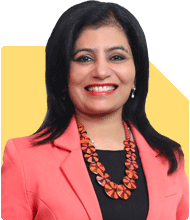40-Year-Old Aiming for Retirement at 60: How Much Can I Gain with Rs. 10,000 Monthly SIP?
Milind Vadjikar |851 Answers |Ask -Follow
Insurance, Stocks, MF, PF Expert - Answered on Oct 17, 2024
He has a mechanical engineering degree from Government Engineering College, Sambhajinagar, and an MBA in international business from the Symbiosis Institute of Business Management, Pune.
With over 16 years of experience in stock investments, and over six year experience in investment guidance and support, he believes that balanced asset allocation and goal-focused disciplined investing is the key to achieving investor goals.... more

U am 40 years now and as usual i want to retier at 60 year. From past 1 year i am investing 10k per month. How much i can get teturns after 20 years. Can you suggest best SIP as i am using COIN app nothing but Kite. Please suggest best sip
From the monthly sip of 10 K which you have started one year back, you may expect a corpus to f 1.32 Cr after 60 years considering a modest return of 13% from pure equity mutual fund scheme.
You may do a sip in large and midcap type mutual fund for eg Kotak Emerging Opportunities Fund.
Happy Investing!!
*Investments in mutual funds are subject to market risks. Please read all scheme related documents carefully before investing.
You may like to see similar questions and answers below
Nikunj Saraf | Answer |Ask -Follow
Mutual Funds Expert - Answered on Feb 16, 2023
Ramalingam Kalirajan |7489 Answers |Ask -Follow
Mutual Funds, Financial Planning Expert - Answered on May 08, 2024
Ramalingam Kalirajan |7489 Answers |Ask -Follow
Mutual Funds, Financial Planning Expert - Answered on May 18, 2024
Ramalingam Kalirajan |7489 Answers |Ask -Follow
Mutual Funds, Financial Planning Expert - Answered on Oct 16, 2024
Dr Anshuman Manaswi |25 Answers |Ask -Follow
Plastic-Aesthetic Surgeon, Emergency Care Consultant - Answered on Jan 10, 2025
Dr Anshuman Manaswi |25 Answers |Ask -Follow
Plastic-Aesthetic Surgeon, Emergency Care Consultant - Answered on Jan 10, 2025
Mihir Tanna |983 Answers |Ask -Follow
Tax Expert - Answered on Jan 10, 2025
Ramalingam Kalirajan |7489 Answers |Ask -Follow
Mutual Funds, Financial Planning Expert - Answered on Jan 10, 2025
Milind Vadjikar |851 Answers |Ask -Follow
Insurance, Stocks, MF, PF Expert - Answered on Jan 10, 2025
Ramalingam Kalirajan |7489 Answers |Ask -Follow
Mutual Funds, Financial Planning Expert - Answered on Jan 10, 2025
Ramalingam Kalirajan |7489 Answers |Ask -Follow
Mutual Funds, Financial Planning Expert - Answered on Jan 10, 2025
Ramalingam Kalirajan |7489 Answers |Ask -Follow
Mutual Funds, Financial Planning Expert - Answered on Jan 10, 2025
Archana Deshpande |95 Answers |Ask -Follow
Image Coach, Soft Skills Trainer - Answered on Jan 10, 2025
Samraat Jadhav |2156 Answers |Ask -Follow
Stock Market Expert - Answered on Jan 10, 2025


























